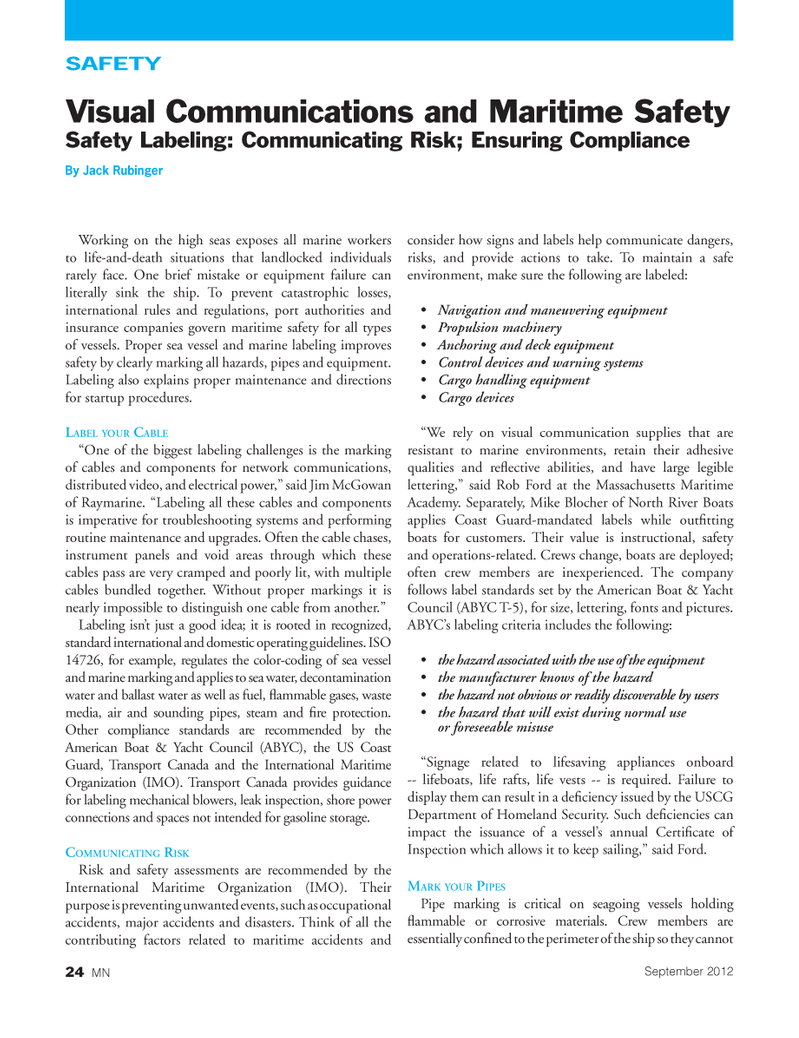
Page 24: of Marine News Magazine (September 2012)
Environment: Stewardship & Compliance
Read this page in Pdf, Flash or Html5 edition of September 2012 Marine News Magazine
SAFETYWorking on the high seas exposes all marine workers to life-and-death situations that landlocked individuals rarely face. One brief mistake or equipment failure can literally sink the ship. To prevent catastrophic losses, international rules and regulations, port authorities and insurance companies govern maritime safety for all types of vessels. Proper sea vessel and marine labeling improves safety by clearly marking all hazards, pipes and equipment. Labeling also explains proper maintenance and directions for startup procedures. LABEL YOUR CABLE ?One of the biggest labeling challenges is the marking of cables and components for network communications, distributed video, and electrical power,? said Jim McGowan of Raymarine. ?Labeling all these cables and components is imperative for troubleshooting systems and performing routine maintenance and upgrades. Often the cable chases, instrument panels and void areas through which these cables pass are very cramped and poorly lit, with multiple cables bundled together. Without proper markings it is nearly impossible to distinguish one cable from another.? Labeling isn?t just a good idea; it is rooted in recognized, standard international and domestic operating guidelines. ISO 14726, for example, regulates the color-coding of sea vessel and marine marking and applies to sea water, decontamination water and ballast water as well as fuel, ammable gases, waste media, air and sounding pipes, steam and re protection. Other compliance standards are recommended by the American Boat & Yacht Council (ABYC), the US Coast Guard, Transport Canada and the International Maritime Organization (IMO). Transport Canada provides guidance for labeling mechanical blowers, leak inspection, shore power connections and spaces not intended for gasoline storage. COMMUNICATING RISK Risk and safety assessments are recommended by the International Maritime Organization (IMO). Their purpose is preventing unwanted events, such as occupational accidents, major accidents and disasters. Think of all the contributing factors related to maritime accidents and consider how signs and labels help communicate dangers, risks, and provide actions to take. To maintain a safe environment, make sure the following are labeled: Navigation and maneuvering equipment Propulsion machinery Anchoring and deck equipment Control devices and warning systems Cargo handling equipment Cargo devices ?We rely on visual communication supplies that are resistant to marine environments, retain their adhesive qualities and re ective abilities, and have large legible lettering,? said Rob Ford at the Massachusetts Maritime Academy. Separately, Mike Blocher of North River Boats applies Coast Guard-mandated labels while out tting boats for customers. Their value is instructional, safety and operations-related. Crews change, boats are deployed; often crew members are inexperienced. The company follows label standards set by the American Boat & Yacht Council (ABYC T-5), for size, lettering, fonts and pictures. ABYC?s labeling criteria includes the following: the hazard associated with the use of the equipment the manufacturer knows of the hazard the hazard not obvious or readily discoverable by users the hazard that will exist during normal use or foreseeable misuse ?Signage related to lifesaving appliances onboard -- lifeboats, life rafts, life vests -- is required. Failure to display them can result in a de ciency issued by the USCG Department of Homeland Security. Such de ciencies can impact the issuance of a vessel?s annual Certi cate of Inspection which allows it to keep sailing,? said Ford. MARK YOUR PIPES Pipe marking is critical on seagoing vessels holding ammable or corrosive materials. Crew members are essentially con ned to the perimeter of the ship so they cannot Visual Communications and Maritime Safety Safety Labeling: Communicating Risk; Ensuring ComplianceBy Jack Rubinger24 MNSeptember 2012MNSept2012 Layout 18-31.indd 24MNSept2012 Layout 18-31.indd 248/31/2012 9:23:07 AM8/31/2012 9:23:07 AM

 23
23

 25
25
